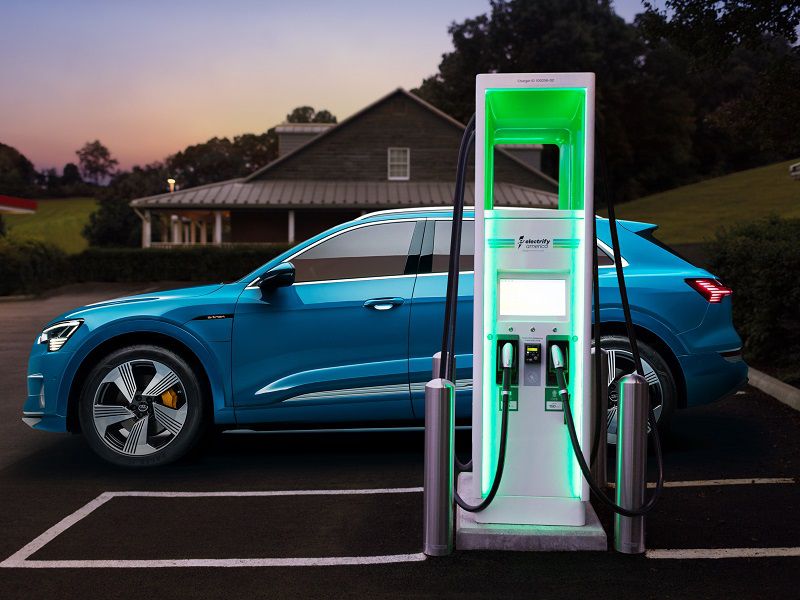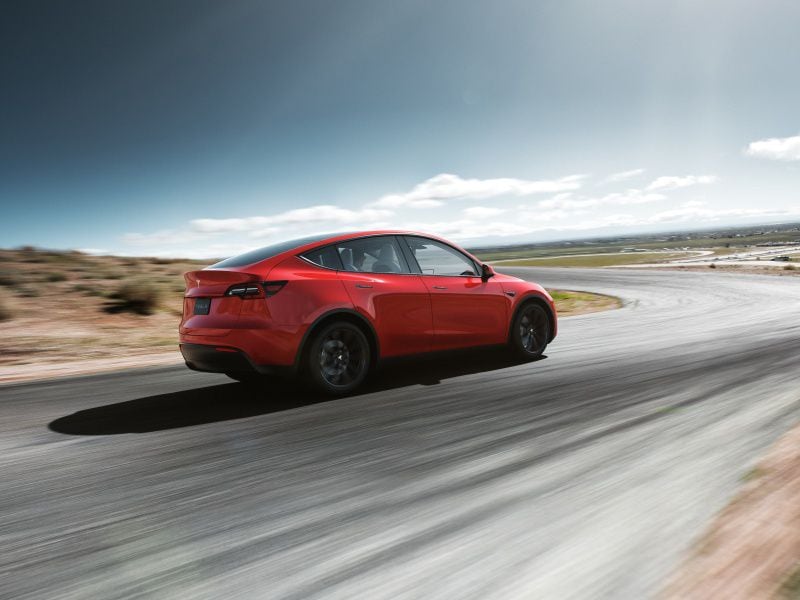Recent Articles
Popular Makes
Body Types
EV Incentives for California and New York

2020 Mini SE Hardtop ・ Photo by MINI
There are many good reasons to like electric cars. Their acceleration is smooth, linear, rapid, and powerful. The immediate torque from electric motors gives EVs exceptional drivability, which is a key reason that luxury-vehicle manufacturers and supercar builders are turning to electric power for their most leading-edge designs.
But it isn’t EV’s speed and high-performance potential that interests many consumers in purchasing electric vehicles. It is their concern for the environment. Electric vehicles are considered to be “zero-emission” vehicles, and since exhaust emissions both pollute and might contribute to global climate change, some consumers prefer them to conventional cars. Federal, state, and even local governments have joined the effort to promote the quick adoption of EVs by subsidizing their purchase. And many publicly and privately owned utilities have similarly gotten on board with incentives to promote EV sales.
Why are incentives necessary?
Though “modern” electric vehicles were introduced to the American market in the 1990s, they have struggled to win wide acceptance despite their many virtues. The counterpart to their clean operation and excellent user-friendliness is their expense.
Battery assemblages that will store enough energy to provide operating ranges that are acceptable to the average American simply cost a lot of money. Though the price of stored battery power has continued to decline as battery technology has improved, battery packs still are so costly that battery-electric vehicles are much more expensive to build and buy than conventional internal-combustion-engine-powered cars, trucks, and SUVs. This high-cost and the associated range sacrifices that are associated with it have prevented wholesale adoption of EVs up to now.

Market Forces or Subsidies?
Based on the cost problem that battery EVs have versus conventional cars, two broad courses for the future are possible. One course is to let the economics of the free market determine the consumer cost to obtain an EV. That exact scenario unfolded a little over 100 years ago when battery electric vehicles first competed with the gasoline-powered vehicles of the day. In that battle, gasoline cars prevailed because of their cost advantages and refueling capabilities that endow them with virtually unlimited range.
But gasoline- and diesel-powered cars pollute and emit carbon dioxide that is tied to global climate change. With that in mind, both federal and some state governments have enacted laws and regulations that subsidize the purchase of electric vehicles. The reasons behind this are twofold. First, simply having EVs on the road can foster cleaner air and a better environment. Second, subsidizing sales of EVs is thought to give the EV industry a boost until it can function without them, sort of like training wheels on a bicycle. While the federal government’s basic EV subsidy — a tax credit that tops out at $7,500 — is uniform across the United States, each of the states has had the opportunity to add its own incentives and subsidies.

Photo by Audi
Electric Vehicle Sales Are Regional
You might expect that electric vehicle sales are fairly uniform across the country. After all, we pretty much all drive cars, don’t we? But the fact is that the vast bulk of EVs sales and EVs in operation in the United States occur in just one state — California.
In the Golden State, electric vehicles represent somewhere between 4% and 5% of overall new light-vehicle sales. EVs also do fairly well in a handful of other states, notably Oregon, Washington, and New York. But because the population of California is larger than the populations of those states, California is far and away the leader in electric vehicle sales and electric vehicles in operation. Put in numerical terms, nearly 50% of all EVs sold in the U.S. are sold in California and more than 50% of EVs on the road do their driving in the Golden State. For perspective, New York is the No. 2 state in terms of EV sales but it represents less than 5% of the total EV market, a stark difference from California.

Photo by Chaosamran_Studio - stock.adobe.com
Why the Discrepancy?
There are two reasons California seems virtually like a different country when it comes to its citizens’ affection for EVs. First, living in the state that was most impacted by smog and air pollution caused by automobiles dating back to the ’50s and ’60s, Californians have had a long history of preferring vehicles that are least likely to foul the air and/or have environmental consequences.
With that as background, the state established the California Air Resources Board (CARB) and fostered the creation of local air quality management districts to help police polluters. In this spirit, California has also created several initiatives to foster the purchase of vehicles that pollute as little as possible. Included in those initiatives are not only vehicle restrictions and smog testing standards but also subsidies and incentives that mean dollars and cents to those consumers who buy zero-emission electric vehicles. Over time a handful of other states have emulated California’s stance both with their own emissions regulations and their own subsidies for electric vehicle purchase.

Photo by logoboom - stock.adobe.com
Rich Subsidy, Poor Subsidy
Some states offer their citizens very substantial subsidies for the purchase of a new EV. As you might expect, over time California has offered the most generous of these subsidies, and, when combined with various initiatives from localities and utilities, a consumer buying an electric vehicle in California could qualify for up to $21,000 in incentives, according to the comprehensive website PlugStar.
That said, you should understand that the typical EV buyer will not qualify for nearly that much. A wide variety of variables that include the vehicle you are purchasing and your income and tax status all figure into the amount you might receive. What is clear, however, is that in states other than California, the incentives to buy an EV are just not as extravagant. Further, virtually none of the subsidies is forever. They have a tendency to come and go with the vagaries of individual state finances and the politicians who happen to be in power. For example, Georgia once had a bountiful subsidy for electric vehicle purchases — but when that ended in the middle of the decade, EV sales in Georgia plunged.

Photo by konoplizkaya - stock.adobe.com
Federal EV Tax Credit
One subsidy that has remained fairly constant is the Federal Electric Vehicle Tax Credit. Instituted in 2010 in an effort to jumpstart electric car use in the United States, the program enables buyers of new EVs to deduct as much as $7,500 from their income tax liability for the year in which the car is purchased.
But right now cars from the two biggest sellers of EVs in the United States — Tesla Motors and General Motors (which currently sells the popular Chevrolet Bolt EV) — do not qualify for the tax incentive. When the tax credit was established, lawmakers set a 200,000-vehicle limit on the number of EVs from a single manufacturer that qualifies, and both Tesla and GM have passed that threshold. There was a phased drawdown for those two automakers in which lesser tax breaks were offered, but those have ended as well. It looks as if Nissan with its Leaf EV or Ford with its new Mustang Mach E could be the next manufacturers to pass the 200,000-unit limit, but that is not imminent as this is being written.

Photo by Tesla
California Incentives
The state of California offers a lengthy list of potential rebates and incentives for the purchase of an EV. As mentioned, not every consumer qualifies for every incentive and changes in the programs are ongoing. Many are direct subsidies or rebates in contrast to the federal tax credit that requires the consumer to have significant income and income tax liability to get the full benefit.
The key program is the California Clean Vehicle Rebate Project. It offers “rebates” of between $1,000 and $4,500 for the purchase or lease of vehicles that qualify. Those who currently own a “clunker” and plan to replace it with an EV might qualify for the California Vehicle Retirement Consumer Assistance Program. It offers $1,000 to $1,500 to consumers who are retiring specific older less-eco-friendly models. The Clean Vehicle Assistance Program provides grants and affordable financing to low-income Californians who are purchasing a new or used battery-electric vehicle or plug-in hybrid. That could provide up to $5,000 in assistance. Available to all Californians, the California Clean Fuel Reward offers up to $1,500 for the purchase or lease of a new EV.

Photo by zakzeinert - stock.adobe.com
New York Incentives
Open to all New York state residents, the Drive Clean Rebate from the New York State Energy Research and Development Authority offers a point-of-sale rebate with the purchase or lease of a new electric car. More than 40 models of full-electric and plug-in hybrid cars and SUVs qualify for the program.
In comparison to the complications one might encounter with the programs of other states, the New York Drive Clean Rebate is very easy. Buyers simply purchase a qualifying electric car from a participating dealer, and a discount of up to $2,000 will be applied when they pay. For those who decide they want to install high-capacity vehicle charging in their home garage, the New York Alternative Fuels and Electric Vehicle Recharging Property Credit could offer them an income tax credit for 50% of the cost of the “alternative fueling infrastructure,” up to a maximum of $5,000.

Photo by Luciano Mortula
Oregon Incentives
The Oregon Clean Vehicle Rebate Program offers a cash rebate for Oregon drivers who purchase or lease electric vehicles. It is not a tax credit. Oregon’s Department of Environmental Quality says it designed the program to reduce vehicle emissions by encouraging more Oregonians to purchase or lease electric vehicles rather than gas vehicles.
The program contains two rebate options. The Standard Rebate, typically $2,500, applies to Oregonians who purchase or lease a new plug-in hybrid electric vehicle or a new battery electric vehicle. The Charge Ahead Rebate, also typically $2,500, applies to the purchase or lease of a new or used battery-electric vehicle or plug-in hybrid. To qualify for the Charge Ahead Rebate, the purchaser or lessee must be from a low- or moderate-income household. Income requirements vary depending on where the purchaser or lessee resides.

Photo by Nick Wiltgen
Washington Incentives
While Oregon offers a straight-up rebate, neighboring Washington state has a completely different electric vehicle subsidy program.
According to the terms of the Washington EV State Tax Exemption, the retail sales and state use tax of 6.5% does not apply to the sale or lease of new or used passenger vehicles, light-duty trucks, and medium-duty passenger vehicles that are exclusively powered by an alternative vehicle fuel or can run solely on electricity for at least 30 miles. Eligible alternative fuels are, of course, electricity, and also natural gas, propane, and hydrogen. Vehicles cannnot have a selling price that exceeds $45,000 for new vehicles and $30,000 for used vehicles. This results in a typical savings of $2,500 to $3,500.

Photo by Adobe Stock